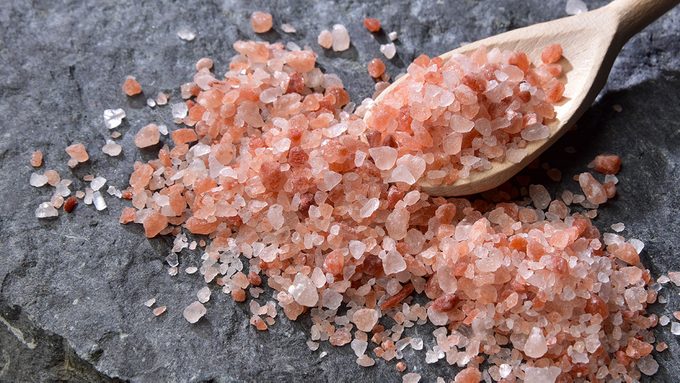Here’s What You Need to Know About Himalayan Pink Salt
It’s pretty, it’s pink, it’s pricey. Himalayan pink salt is the latest “superfood” to hit our shelves (and our pockets). But is all the hype true?

Is Himalayan pink salt really healthier?
We all know that too much salt can cause health problems — which is why it’s crucial to know the signs that you’re eating too much salt. But it’s hard to resist the appeal of Himalayan pink salt, especially if it has added health benefits. Does it really deliver everything that people are claiming? Let’s sort the fact from the fiction.
What is Himalayan pink salt?
Himalayan salt is the leftover deposits from a salty ocean during the pre-Cambrian age (around four billion years ago). It’s harvested from the Punjab region in Pakistan and contains over 80 minerals and trace elements — some of which give the salt its characteristic pink colour.
Does it have added iodine like table salt?
Pink Himalayan sea salt has no added iodine or anti-clumping agent. However, iodine is essential for our diet, and iodine is added to table salt in the U.S. to prevent iodine deficiency. Registered dietician Kelsey Mangano, PhD, RD, assistant professor at the University of Massachusetts Lowell, explains: “Prior to adding iodine to our table salt, we actually had much higher rates of goiter,” she said, “Which can be a very serious syndrome.”
What are the health claims of Himalayan salt?
It’s often said that the additional trace elements and minerals in Himalayan salt are somehow “better for us” than mere sodium chloride. Fans claim they bring a host of benefits, including easing breathing difficulties, aiding vascular health, helping digestive disorders, improving nutrient absorption, and balancing the body’s PH levels, to name a few. (Here are 15 of the most powerful spring superfoods.)
Do we really need the additional elements?
But just because Himalayan salt isn’t processed to remove these extra elements, it doesn’t follow that they’re necessary to our health. “People are thinking it’s like taking a salt multivitamin,” said Dr. Mangano, “but it actually couldn’t be further from the truth. People need to understand that the number of trace minerals that are essential for health is actually really small. We only need around eight trace minerals to prevent any types of deficiency symptom.”
Can these health claims be proved?
Some sources cite supposed scientific studies showing the superior qualities of Himalayan pink salt. But in reality, these studies either relate to sodium chloride in general, or are not from peer-reviewed studies — the most reliable kind of research. “I couldn’t find a single peep of evidence supporting any reason that ingesting Himalayan salt would have any health benefits,” declared Dr. Mangano.
So should I use Himalayan pink salt?
Used in moderation, salt is an important part of our diet, but you should stick to the current guidelines from the American Heart Association of getting no more than 1500 mg per day. Healthy habits like knowing which foods contain hidden salt and swapping high-salt snacks for low-fat goodies will help. Himalayan pink salt may be your salt of choice but beware of believing all the health claims about it.
“I would advise people to consume the salt that they find is the most flavourful and makes their food the most exciting,” said Dr. Mangano.




